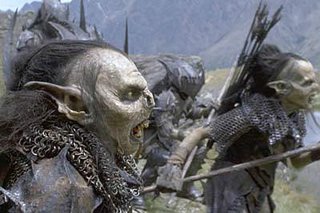
In the post below, the Fu2rman wrote of how Iran is boasting of having 40,000 volunteers to carry out suicide bombings. In the comments section, doubts are being expressed as to whether it could possibly be true that 40,000 Iranians would volunteer for a mission of sure death.
Doubt not (thanks to Christine from Research for sending this in to me):
During the Iran-Iraq War, the Ayatollah Khomeini imported 500,000 small plastic keys from Taiwan. The trinkets were meant to be inspirational. After Iraq invaded in September 1980, it had quickly become clear that Iran's forces were no match for Saddam Hussein's professional, well-armed military. To compensate for their disadvantage, Khomeini sent Iranian children, some as young as twelve years old, to the front lines. There, they marched in formation across minefields toward the enemy, clearing a path with their bodies.
Before every mission, one of the Taiwanese keys would be hung around each child's neck. It was supposed to open the gates to paradise for them.At one point, however, the earthly gore became a matter of concern. "In the past," wrote the semi-official Iranian daily Ettelaat as the war raged on, "we had child-volunteers: 14-, 15-, and 16-year-olds.
They went into the minefields. Their eyes saw nothing. Their ears heard nothing. And then, a few moments later, one saw clouds of dust. When the dust had settled again, there was nothing more to be seen of them. Somewhere, widely scattered in the landscape, there lay scraps of burnt flesh and pieces of bone." Such scenes would henceforth be avoided, Ettelaat assured its readers.
These children who rolled to their deaths were part of the Basiji, a mass movement created by Khomeini in 1979 and militarized after the war started in order to supplement his beleaguered army.
The Basij Mostazafan--or "mobilization of the oppressed"--was essentially a volunteer militia, most of whose members were not yet 18. They went enthusiastically, and by the thousands, to their own destruction. "The young men cleared the mines with their own bodies," one veteran of the Iran-Iraq War recalled in 2002 to the German newspaper Frankfurter Allgemeine. "It was sometimes like a race. Even without the commander's orders, everyone wanted to be first."
The chief combat tactic employed by the Basiji was the human wave attack, whereby barely armed children and teenagers would move continuously toward the enemy in perfectly straight rows. It did not matter whether they fell to enemy fire or detonated the mines with their bodies: The important thing was that the Basiji continue to move forward over the torn and mutilated remains of their fallen comrades, going to their deaths in wave after wave.
Once a path to the Iraqi forces had been opened up, Iranian commanders would send in their more valuable and skilled Revolutionary Guard troops.
This approach produced some undeniable successes. "They come toward our positions in huge hordes with their fists swinging," one Iraqi officer complained in the summer of 1982. "You can shoot down the first wave and then the second. But at some point the corpses are piling up in front of you, and all you want to do is scream and throw away your weapon. Those are human beings, after all!"
By the spring of 1983, some 450,000 Basiji had been sent to the front. After three months, those who survived deployment were sent back to their schools or workplaces.
At the beginning of the war, Iran's ruling mullahs did not send human beings into the minefields, but rather animals: donkeys, horses, and dogs. But the tactic proved useless: "After a few donkeys had been blown up, the rest ran off in terror," Mostafa Arki reports in his book Eight Years of War in the Middle East.
The donkeys reacted normally--fear of death is natural. The Basiji, on the other hand, marched fearlessly and without complaint to their deaths.
And, Ahmadinejad has a special relationship with the Basij, as he was among their numbers himself:
It was this culture that nurtured Mahmoud Ahmadinejad's worldview. What exactly did he do during the war? These are questions for which we have no definite answers. His presidential website says simply that he was "on active service as a Basij volunteer up to the end of the holy defense [the war against Iraq] and served as a combat engineer in different spheres of duty."
Ahmadinejad revels in his alliance with the Basiji. He regularly appears in public wearing a black-and-white Basij scarf, and, in his speeches, he routinely praises "Basij culture" and "Basij power," with which he says "Iran today makes its presence felt on the international and diplomatic stage."
4 comments:
Very good read. Shocking how children can be turned into Islamo-zombies by their thousands.
It's funny, "orc" has been our code word for Muslims in public since pretty much 9/11. Let them start detonating. Then go to The Ultimate Insult and take part in my Middle East Map Fill in the Blank Contest. Iran's just not going to be there, IMO.
BTW, has anyone else here had Technorati stop taking their 'pings'? They won't take mine and haven't for a week....and won't write me back....just wondering. Thanks.
Hi PG,
The piece was originally called "Ahmadinejad's Demons," but "The Orcs" just seemed a more apropo title to me.
Just thinking about some Evolutionary theory here. Wasn't there something that was supposed to separate us from animals? Man....what was that....oh yeah THOUGHT!
I'd give them a sign, but they are in pieces. Go go the power of Iran; you are the weakest link!
Post a Comment